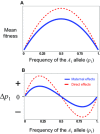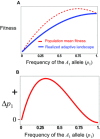Evolutionary genetics of maternal effects
- PMID: 26969266
- PMCID: PMC4926267
- DOI: 10.1111/evo.12905
Evolutionary genetics of maternal effects
Abstract
Maternal genetic effects (MGEs), where genes expressed by mothers affect the phenotype of their offspring, are important sources of phenotypic diversity in a myriad of organisms. We use a single-locus model to examine how MGEs contribute patterns of heritable and nonheritable variation and influence evolutionary dynamics in randomly mating and inbreeding populations. We elucidate the influence of MGEs by examining the offspring genotype-phenotype relationship, which determines how MGEs affect evolutionary dynamics in response to selection on offspring phenotypes. This approach reveals important results that are not apparent from classic quantitative genetic treatments of MGEs. We show that additive and dominance MGEs make different contributions to evolutionary dynamics and patterns of variation, which are differentially affected by inbreeding. Dominance MGEs make the offspring genotype-phenotype relationship frequency dependent, resulting in the appearance of negative frequency-dependent selection, while additive MGEs contribute a component of parent-of-origin dependent variation. Inbreeding amplifies the contribution of MGEs to the additive genetic variance and, therefore enhances their evolutionary response. Considering evolutionary dynamics of allele frequency change on an adaptive landscape, we show that this landscape differs from the mean fitness surface, and therefore, under some condition, fitness peaks can exist but not be "available" to the evolving population.
Keywords: Kin selection; Social effects; adaptive landscape; dominance; frequency dependent selection.
© 2016 The Author(s). Evolution published by Wiley Periodicals, Inc. on behalf of The Society for the Study of Evolution.
Figures



References
-
- Arnold, S. J. 2003. Performance surfaces and adaptive landscapes. Integr. Comp. Biol. 43:367–375. - PubMed
-
- Badyaev, A. V. , Hill G. E., Beck M. L., Dervan A. A., Duckworth R. A., McGraw K. J., Nolan P. M., and Whittingham L. A.. 2002. Sex‐biased hatching order and adaptive population divergence in a passerine bird. Science 295:316–318. - PubMed
-
- Baroux, C. , Autran D., Gillmor C. S., Grimanelli D., and Grossniklaus U.. 2008. The maternal to zygotic transition in animals and plants. Cold Spring Harb. Symp. Quant. Biol. 73:89–100. - PubMed
Publication types
MeSH terms
Grants and funding
LinkOut - more resources
Full Text Sources
Other Literature Sources
